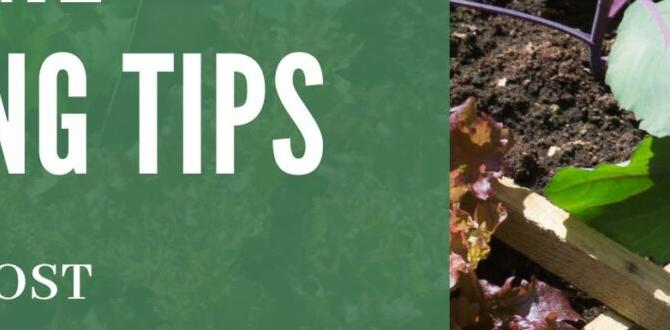Quick Summary: Discover the best organic fertilizers for robust plant growth! This guide reveals earth-friendly options proven to nourish your soil and boost yields, turning brown thumbs green with simple, sustainable solutions.
Best Organic Fertilizers: Proven Growth Essentials
Are your plants looking a little sad? Maybe they aren’t growing as much as you’d hoped. It’s a common frustration for gardeners, whether you’re starting out with a few herbs on a sunny windowsill or tending a backyard vegetable patch. The good news is that the solution is often simpler than you think. It all comes down to feeding your soil, which in turn feeds your plants. We’re going to explore the wonderful world of organic fertilizers, your secret weapon for healthier, happier, and more productive plants, all while being kind to the planet.
This guide will walk you through the best organic fertilizer options, explaining what they are, why they work, and how to use them. You’ll learn to choose the perfect nutrient boost for any plant, making your gardening journey a breeze. Get ready to unlock your plants’ full potential!
Why Choose Organic Fertilizers?
Before we dive into the specifics, let’s chat about why going organic with your plant food is a fantastic idea. Think of it this way: synthetic fertilizers can give plants a quick boost, almost like a sugary snack. They deliver nutrients directly to the plant, leading to rapid green up. However, this can sometimes be at the expense of long-term soil health.
Organic fertilizers, on the other hand, are like a wholesome, balanced meal for your soil. They work by feeding the beneficial microorganisms in your soil. These tiny helpers then break down the organic matter, slowly releasing nutrients that plants can readily absorb. This process not only feeds your plants but also improves the soil structure, water retention, and overall fertility over time. It’s a win-win for your garden and the environment!
Here’s a quick look at the advantages:
- Improves Soil Health: They build up organic matter, leading to better aeration, drainage, and water retention.
- Slow & Steady Nutrient Release: This prevents nutrient “burn” and feeds plants for a longer period.
- Eco-Friendly: They are sustainable, renewable, and generally have a lower environmental impact.
- Safe for Edibles: Perfect for vegetable gardens and herb patches, as they don’t leave harmful residues.
- Supports Beneficial Microbes: They encourage a thriving ecosystem in your soil.
Understanding Fertilizer Basics: N-P-K and More
You’ve probably seen bags of fertilizer with three numbers on them, like 10-10-10 or 5-5-5. These numbers represent the percentage of three main nutrients, known as macronutrients, that your plants need in large amounts. They are:
- N (Nitrogen): Crucial for leafy green growth and vibrant foliage. It’s like protein for your plant’s leaves.
- P (Phosphorus): Essential for strong root development, flowering, and fruiting. Think of it as the building block for roots and blooms.
- K (Potassium): Important for overall plant health, disease resistance, and water regulation. This is your plant’s immune system booster.
These numbers represent the guaranteed analysis of available nutrients. For example, a 5-5-5 fertilizer contains 5% nitrogen, 5% phosphorus, and 5% potassium by weight.
Beyond these primary macronutrients, plants also need secondary macronutrients (like calcium, magnesium, and sulfur) and micronutrients (like iron, manganese, and zinc) in smaller amounts. Organic fertilizers are fantastic because they often contain a broad spectrum of these essential nutrients, providing a more complete feeding package.
The Best Organic Fertilizers for Every Gardener
Now for the exciting part! Let’s explore some of the most popular and effective organic fertilizers you can easily find and use. We’ll cover what they are, their primary benefits, and how to best apply them.
1. Compost: The Gardener’s Gold
What it is: Compost is decomposed organic matter – think kitchen scraps (veggie peels, coffee grounds, eggshells), yard waste (leaves, grass clippings – avoid treated grass), and other natural materials. You can buy it or make your own! Making your own compost is a super rewarding way to reduce waste and create incredible plant food.
Why it’s great: It’s the ultimate all-rounder. Compost slowly releases a wide range of nutrients, improves soil structure dramatically, helps retain moisture, and encourages beneficial microbial activity. It’s gentle and effective for all types of plants.
How to use it:
- As a soil amendment: Mix a few inches into your garden beds before planting.
- As a top dressing: Spread a layer around existing plants, especially in spring and fall.
- In containers: Mix it with potting soil for a nutrient-rich base.
Find out more about composting from the Environmental Protection Agency (EPA).
2. Aged Manure: Nature’s Powerhouse
What it is: This refers to manure from livestock like cows, horses, chickens, or sheep that has been aged or composted. Fresh manure can be too strong and “hot” for plants, potentially burning their roots. Aging or composting breaks down the harsh compounds and kills weed seeds.
Why it’s great: Manure is rich in nitrogen and other essential nutrients. It also adds valuable organic matter to the soil, improving its texture and fertility. Different types of manure offer slightly different nutrient profiles:
- Chicken manure: High in nitrogen, phosphorus, and calcium; needs good composting.
- Cow manure: A well-balanced, slow-release option.
- Horse manure: Good for adding organic matter; often lower in nutrient strength but beneficial for soil structure.
- Sheep manure: Similar to cow manure, well-balanced and excellent for soil.
How to use it:
- Always use aged or composted manure.
- Mix into garden beds before planting, like compost. Generally, apply 1-2 inches into the soil.
- Avoid using it directly on young seedlings.
3. Worm Castings (Vermicompost): Tiny But Mighty
What it is: This is the excrement of earthworms. Worms consume organic matter, and their digestive process creates nutrient-rich, highly beneficial “castings.” You can buy them or even start your own worm bin!
Why it’s great: Worm castings are incredibly rich in nutrients, as well as beneficial microbes. They are a complete fertilizer, providing a wide array of macro- and micronutrients in a form that plants can easily absorb. They also improve soil structure and water retention without the risk of over-fertilizing.
How to use it:
- As a top dressing: Sprinkle a thin layer around plants.
- Mixed with potting soil: Use about 10-20% worm castings in your potting mix for containers.
- As a “tea”: Steep castings in water for a liquid feed (worm tea).
4. Seaweed Extract / Fish Emulsion: Liquid Gold from the Ocean
What it is:
- Seaweed Extract: Made from kelp or other seaweeds, often processed into liquid or granular forms.
- Fish Emulsion: Made from the leftover parts of fish processing. It can be potent!
Why it’s great: These liquid fertilizers provide a quick boost of nutrients, including nitrogen and phosphorus, along with a host of micronutrients and beneficial growth hormones. Seaweed extract, in particular, also contains compounds that can help plants resist stress and disease.
How to use it:
- Follow the dilution instructions on the package carefully. Too much can be harmful.
- Usually applied as a foliar spray (on leaves) or watered into the soil around the base of plants.
- Ideal for a mid-season boost when plants really need it.
5. Bone Meal: For Roots and Blooms
What it is: A byproduct of the meat-packing industry, bone meal is made from ground animal bones. It is typically high in phosphorus (P) and calcium (Ca).
Why it’s great: Excellent for promoting strong root development and encouraging prolific flowering and fruiting. It’s a key ingredient for blooming plants like roses and vegetables that produce fruits.
How to use it:
- Mix into the soil before planting, especially in areas where you’ll plant bulbs, root vegetables, or flowering plants.
- Usually applied at a rate of 1-2 pounds per 100 square feet.
- Soils that are on the acidic side work best for bone meal absorption.
- Note: Avoid using bone meal if you have pets, as they can be attracted to the smell and dig it up.
6. Blood Meal: For Leafy Growth
What it is: Made from dried animal blood, often from cattle. It’s ground into a powder. Blood meal is highly concentrated in nitrogen (N).
Why it’s great: If your plants need a quick surge of green, leafy growth, blood meal is your go-to. It’s particularly useful for leafy vegetables like lettuce and spinach, or for plants that are showing signs of nitrogen deficiency (yellowing leaves).
How to use it:
- Use sparingly and mix into the soil.
- High nitrogen content means it can easily burn plants if over-applied. Follow package directions closely.
- Generally applied at a rate of about 1 pound per 100 square feet.
- It can slightly lower soil pH, which is beneficial for acid-loving plants.
7. Alfalfa Meal: A Balanced Boost
What it is: Made from dried, ground alfalfa plants. It’s a fantastic all-around soil amendment.
Why it’s great: Alfalfa meal is a source of nitrogen, phosphorus, and potassium, plus many trace minerals and vitamins. It also contains a natural growth stimulant that encourages stronger root systems and overall plant vigor. It acts as a slow-release fertilizer and helps improve soil structure.
How to use it:
- Mix into garden beds before planting or top-dress around established plants.
- Works well for vegetables, flowers, and lawns.
- Can be used at a rate of 2-4 pounds per 100 square feet.
When and How to Fertilize Your Plants
Knowing what to use is half the battle; knowing when and how is the other crucial half. Over-fertilizing can be just as bad as under-fertilizing!
Timing is Everything
The best time to fertilize depends on the plant and its growth stage:
- Before Planting: Incorporate compost or aged manure into the soil to build a nutrient-rich foundation. Bone meal is also great at this stage for flowering and root crops.
- During the Growing Season: This is when plants are actively growing and need consistent feeding.
- Vegetables and Flowers: A balanced organic fertilizer (like compost tea, fish emulsion, or alfalfa meal) every 4-6 weeks can be beneficial.
- Leafy Greens: May benefit from a slightly higher nitrogen source, like blood meal or compost, as they grow.
- Fruiting Plants (tomatoes, peppers, berries): Once they start to set fruit, phosphorus and potassium become more important. You might alternate between a balanced fertilizer and one higher in P and K, or use compost tea regularly.
- Container Plants: Plants in pots rely entirely on what you give them and their nutrients leach out faster. They generally need more frequent feeding than garden plants. A diluted liquid organic fertilizer every 2-4 weeks is often recommended.
- Established Trees and Shrubs: Typically don’t need much fertilizer once established, especially if they are mulched with organic material. If growth is slow or leaves are pale, a spring application of compost or a slow-release organic fertilizer can help.
Application Methods: Making it Easy
How you apply your fertilizer can also impact its effectiveness:
- Incorporating into Soil: For granular fertilizers like bone meal, blood meal, or alfalfa meal, gently mix them into the top few inches of soil before planting or around established plants. This protects them from washing away and makes them accessible to roots.
- Top Dressing: Spreading a layer of compost or worm castings on the soil surface around plants allows rain and watering to carry nutrients down to the roots over time. Keep it a few inches away from plant stems.
- Liquid Fertilizers (Foliar Spray or Soil Drench): Diluted fish emulsion, seaweed extract, or compost tea can be applied directly to the soil around the plant’s base or sprayed onto the leaves. Foliar feeding offers a quicker absorption but is generally a temporary fix. Always follow dilution rates specific to the product to avoid burning plants.
Choosing the Right Fertilizer for Your Needs
With so many options, how do you pick the “best” organic fertilizer? It really depends on what your plants need and your gardening situation.
Consider Your Plants
- Leafy Greens (lettuce, spinach, kale): Need high nitrogen (N). Look for blood meal, compost, or nitrogen-rich fish emulsion.
- Flowering Plants (roses, petunias, impatiens): Need balanced nutrients with a boost of phosphorus (P) for blooms. Bone meal, alfalfa meal, and balanced compost are great.
- Fruiting Plants (tomatoes, peppers, berries): Need balanced nutrients to start, then more P and K when flowering and fruiting. Compost, bone meal, and a balanced organic fertilizer are good.
- Root Vegetables (carrots, potatoes, radishes): Need good phosphorus (P) and potassium (K) for root development. Bone meal and compost are excellent choices.
- Seedlings and Young Plants: Need gentle, readily available nutrients. Worm castings are perfect for their mildness and broad nutrient profile.
- Lawns: Benefit from a balanced organic fertilizer like compost or alfalfa meal.
Consider Your Soil
If you have a soil test done (many local extension offices offer this service), you’ll know exactly which nutrients are lacking. However, for most beginner gardeners, a general-purpose organic approach is a great start.
- Clay Soil: Benefits most from organic matter to improve drainage and aeration. Compost is your best friend here.
- Sandy Soil: Tends to drain quickly and lose nutrients. Organic fertilizers feed the soil and help it retain moisture and nutrients better. Compost and aged manure are excellent.
Consider Your Goals
- For the Biggest Harvests: Balance is key. Use compost regularly and supplement with specific nutrients like bone meal for flowering/fruiting plants based on their needs.
- For Soil Health: Focus on adding copious amounts of compost and worm castings. These improve soil structure and feed the beneficial microbes over the long term.
- For Convenience: Ready-made organic fertilizer blends, granular or liquid, can be easier to handle.
DIY Organic Fertilizer Boosts
Want to get even more hands-on and eco-friendly? Some common household items can be repurposed into excellent plant food:
- Coffee Grounds: Add nitrogen and other trace minerals. Can slightly acidify soil. Mix into compost or top-dress lightly.
- Banana Peels: Rich in potassium. Chop them up and bury them shallowly around plants, or add them to your compost.
- Eggshells: A source of calcium, which helps prevent blossom end rot in tomatoes and peppers. Wash, dry, and crush them into a fine powder before mixing into soil.
- Epsom Salts (Magnesium Sulfate): Provides magnesium and sulfur, which can be beneficial for plants that tend to yellow leaves and for flowering plants. Dissolve 1-2 tablespoons in a gallon of water and use as a soil drench or foliar spray. Use sparingly.
FAQ: Your Organic Fertilizer Questions Answered
Q1: How often should I fertilize my houseplants?
A1: Most houseplants benefit from fertilization during their active growing season (spring and summer), typically once a month. Use a diluted liquid organic fertilizer formulated for houseplants. Reduce or stop fertilizing in fall and winter when plant growth naturally slows down.
Q2: Can I use organic fertilizer on my lawn?
A2: Absolutely! Organic fertilizers



